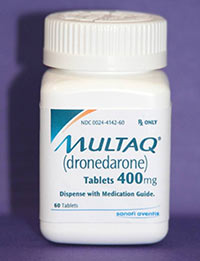Reduces cardiovascular hospitalization risk
COMPANY: Sanofi Aventis
PHARMACOLOGIC CLASS: Antiarrhythmic
ACTIVE INGREDIENT: Dronedarone 400mg; tabs.
INDICATION: To reduce risk of cardiovascular hospitalization in patients with paroxysmal or persistent atrial fibrillation (AF) or atrial flutter (AFL) with a recent episode of AF/AFL and cardiovascular risk factors (age >70 years, HTN, diabetes, prior cerebrovascular accident, left atrial diameter ³50mm or LVEF <40%, who are in sinus rhythm or who will be cardioverted.
PHARMACOLOGY: Dronedarone is an antiarrhythmic drug that has properties belonging to all four types of antiarrhythmic agents (Classes I-IV).
CLINICAL TRIALS: In the ATHENA study, 4628 patients who had AF/AFL and sinus rhythm were treated for up to 30 months with either the study drug or placebo, in addition to conventional therapy. The primary endpoint was the time to first hospitalization for cardiovascular reasons or death from any cause. Compared to placebo, dronedarone reduced the combined endpoint of cardiovascular hospitalization or death from any cause by 24.2%. In two other studies, EURIDIS and ADONIS, 1237 outpatients who had a prior episode of AF/AFL and who were in sinus rhythm were given either dronedarone or placebo, in combination with conventional therapy, and were followed for 12 months. Dronedarone delayed the time to first recurrence of AF/AFL, lowering the risk of first AF/AFL recurrence by about 25%, with an absolute difference in recurrence rate of about 11% at 12 months. In the ANDROMEDA study, patients recently hospitalized with symptomatic heart failure (HF) and severe left ventricular systolic dysfunction were given either dronedarone or placebo. The primary composite endpoint was all-cause mortality or hospitalization for HF. This study was terminated early because of increased mortality in the dronedarone group, mostly due to worsening HF.
ADULTS: ≥18 years: 400mg twice daily (AM & PM) with meals.
CHILDREN: <18 years: not recommended.
CONTRAINDICATIONS: NYHA Class IV HF. NYHA Class II–III HF with recent decompensation requiring hospitalization or referral to a specialized HF clinic. 2nd- or 3rd-degree AV block or sick sinus syndrome, unless paced. Bradycardia (<50 bpm). Concomitant strong CYP3A inhibitors (eg, ketoconazole, itraconazole, voriconazole, cyclosporine, telithromycin, clarithromycin, nefazodone, ritonavir). Concomitant agents that can cause QTc prolongation (eg, phenothiazines, tricyclics, certain oral macrolide antibiotics, Class I and III antiarrhythmics). QTc Bazett interval ≥500ms. PR interval >280ms. Severe hepatic impairment. Pregnancy (Cat.X) (use effective contraception). Nursing mothers.
PRECAUTIONS: Consider suspending or discontinuing if worsening HF develops. Maintain normal serum K+ and Mg+ levels.
INTERACTIONS: See Contraindications. Avoid concomitant antiarrhythmics, CYP3A inducers (eg phenobarbital, carbamazepine, phenytoin, St. John’s wort), grapefruit juice. Reduce digoxin dose by 1/2, reevaluate and monitor. Reduce dose and monitor Ca+ channel blockers, b-blockers (bradycardia), other CYP2D6 substrates. Verapamil, diltiazem increase dronedarone levels. Dronedarone increases verapamil, diltiazem, nifedipine levels. May potentiate some statins, sirolimus, tacrolimus, other narrow-therapeutic range CYP3A substrates: adjust dose and monitor. Monitor other CYP3A or CYP2D6 substrates (eg, SSRIs).
ADVERSE REACTIONS: GI upset, asthenia, rash, increased serum creatinine.
HOW SUPPLIED: Tabs—60, 180, 500
For more information call (800) 981-2491 or visit www.Multaq.com.
